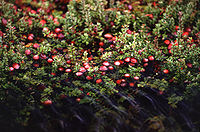
Photo from wikipedia
The conservation of bee populations for pollination in agricultural landscapes has attracted a lot of recent research interest, especially for crop industries undergoing expansion to meet increased production demands. In… Click to show full abstract
The conservation of bee populations for pollination in agricultural landscapes has attracted a lot of recent research interest, especially for crop industries undergoing expansion to meet increased production demands. In Canada, much growth has been occurring with commercial cranberry production, a field crop which is largely dependent on bee pollination. Wild bee pollinators could be negatively impacted by losses of natural habitat surrounding cranberry fields to accommodate increased production, but growers have little insight on how to manage their lands to maximize the presence of wild bees. Here, we described a 2-yr study where bee diversity and species composition were investigated to better understand the dynamic between natural habitat and cranberry fields. Bees were sampled using pan-traps and hand netting both within cranberry fields and in one of the three adjacent natural habitat types once a week during the crop flowering period. We found that bee community composition among cranberry fields did not differ based on the respective adjacent habitat type, but fields bordered by meadows were marginally less diverse than fields bordered by forest. As one would expect, field and natural habitat communities differed in terms of species composition and species richness. There was no evidence that one type of natural habitat was more favorable for the bees than another. Future agrobiodiversity studies should simultaneously examine bee diversity comprised in both crop fields and adjacent natural environments to better understand the species dynamics essential to the preservation of pollination services.
Journal Title: Journal of economic entomology
Year Published: 2017
Link to full text (if available)
Share on Social Media: Sign Up to like & get
recommendations!